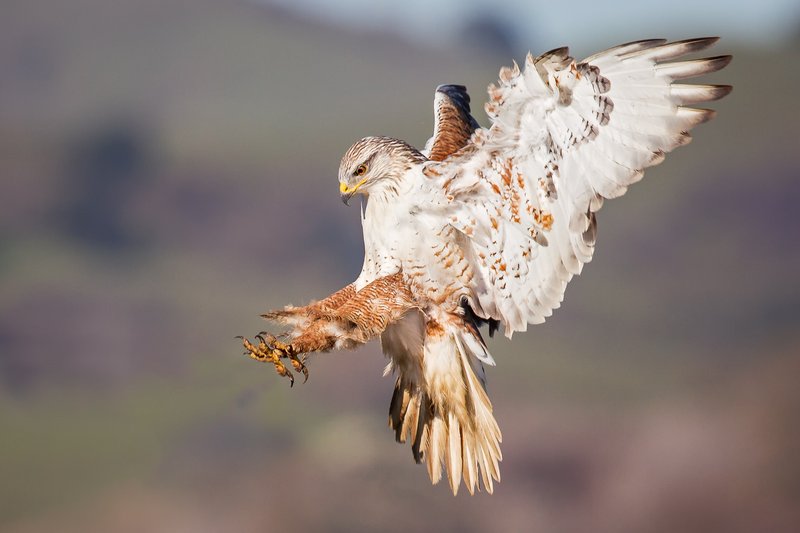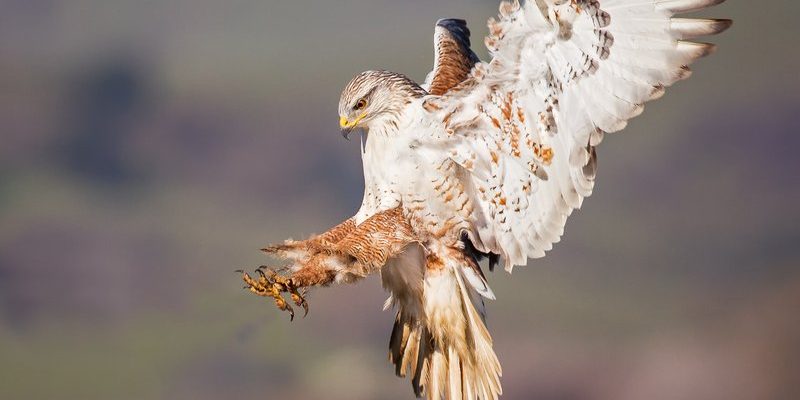
Imagine the Ferruginous Hawk as the ultimate aerial hunter, gliding effortlessly across vast horizons. Its large, powerful wings are perfectly crafted for both soaring and swooping, making it a formidable predator. This hawk doesn’t just rely on speed; it employs a variety of techniques tailored to its environment, prey, and hunting style. Understanding these methods can deepen your appreciation for these magnificent creatures.
This article will take you on a journey examining the fascinating flying and hunting strategies of the Ferruginous Hawk, exploring everything from its unique flight patterns to hunting tactics that set it apart from other birds of prey.
1. Overview of the Ferruginous Hawk
The Ferruginous Hawk is a large raptor native to North America, primarily found in open grasslands and scrublands. It’s known for its striking appearance, featuring a rich brown plumage with a distinct rufous (reddish-brown) color on its legs and back. This coloration helps it blend seamlessly into its environment, making it a stealthy hunter.
These hawks can grow quite large, with wingspans reaching up to 4.5 feet! If you were to see one in flight, you’d notice how gracefully they glide, almost like a seasoned pilot navigating through the sky. Their wings are broad and long, which allows them to ride thermals—columns of rising warm air—effectively. Soaring high above, they can spot prey from great distances, giving them a significant advantage.
Ferruginous Hawks typically hunt small mammals, such as rabbits and rodents, but they can also catch birds or even reptiles when needed. Their adaptability in hunting and feeding habits allows them to thrive in varied habitats, making them one of the most versatile raptors in North America.
2. Soaring: The Art of Gliding
Soaring is one of the most impressive flying techniques employed by the Ferruginous Hawk. Soaring birds use thermals to gain altitude without expending much energy. This method allows them to cover vast areas while searching for food.
Here’s the thing about thermals: they’re like invisible highways in the sky. When the sun warms the ground, it heats the air above it. The warm air rises, creating a thermal. Ferruginous Hawks can catch these rising currents, spreading their wings wide and almost effortlessly riding the thermal up to great heights.
Imagine standing on a sunny hill and feeling the wind lift you as a bird. That’s how these hawks conserve energy while scanning the ground below for tasty morsels. They’ll typically soar at heights of 1,500 to 2,000 feet, giving them spectacular views over their hunting grounds. This skill not only helps them find food but also keeps them safe from potential predators.
3. The Dive: Precision Hunting
While soaring allows the Ferruginous Hawk to locate its prey, the real excitement happens when it goes into a dive. This is known as a stoop, and it’s where the hawk demonstrates its incredible speed and precision.
When the hawk spots something worth pursuing, it will circle a bit before positioning itself for the dive. With wings tucked in close to its body, it can accelerate toward the ground at astonishing speeds. During this descent, it relies on its keen eyesight to track its target. Honestly, it’s like watching a well-trained athlete make a perfect play.
The Ferruginous Hawk can reach speeds of up to 40 miles per hour in a stoop. Imagine a sprinter launching off the starting blocks—this dive is their way of ensuring they arrive at their target quickly and effectively. Once it gets close enough, the hawk uses its sharp talons to seize the prey, often delivering a precise strike that is both swift and lethal.
4. Hunting Techniques: From Stillness to Action
One of the most fascinating aspects of the Ferruginous Hawk’s hunting style is its ability to adapt. Unlike some hawks that prefer a more active approach, the Ferruginous Hawk often employs a combination of stillness and sudden action.
For instance, these hawks frequently hunt from a perch, such as a low tree branch or even on the ground. From this vantage point, they remain perfectly still, scanning the terrain for movement. Imagine watching a movie where the hero lies in wait for just the right moment—this hawk embodies that suspenseful stillness.
When it spots potential prey, it springs into action, launching off its perch. This hunting technique enables it to sneak up on unsuspecting animals, maximizing its chances of a successful catch. Plus, the element of surprise can work wonders in the bird’s favor, allowing it to nab a snack before the prey even knows what happened.
5. Collaborative Hunting: Teamwork in the Skies
What’s particularly intriguing about Ferruginous Hawks is their capacity for collaborative hunting. While many raptors are solitary hunters, Ferruginous Hawks have been observed hunting in pairs or small groups, especially during the breeding season.
Imagine two hawks soaring together, communicating with subtle movements and calls, coordinating their strategy. They can cover more ground this way, increasing their chances of finding food. If one hawk spots a rabbit or a field mouse, the other can help by creating a distraction or driving the prey toward its partner.
This teamwork enhances their effectiveness, especially in areas with abundant prey. It’s a clever adaptation that allows these birds to thrive, showcasing just how smart and resourceful they can be.
6. The Role of Habitat in Hunting Success
The Ferruginous Hawk thrives in open habitats like grasslands, sagebrush, and agricultural fields. These environments are rich in small mammals, the hawk’s primary food source. The open space also allows for the soaring flight that is so crucial to its hunting method.
Habitats with low vegetation are particularly beneficial because they give hawks a clear view of the ground. Think about it: just like a fisherman casting a line in calm waters, the Ferruginous Hawk needs the right conditions to succeed. If the grass is too tall or dense, it’s tricky for the hawk to spot its next meal, which can significantly impact its hunting success.
Additionally, the availability of perches is vital. Ferruginous Hawks often use fence posts or low trees to spot their prey. Without these vantage points, they would struggle to employ their unique hunting techniques effectively. So, preserving these habitats is crucial for the survival of this remarkable bird.
7. Conservation and Challenges
Despite their impressive skills, Ferruginous Hawks face several challenges in the wild. Habitat loss due to urbanization, agriculture, and human development has been a significant threat. When their habitats shrink, so do their chances of finding food and successfully raising their young.
Additionally, they sometimes fall victim to collisions with vehicles or power lines. These risks can make it harder for them to survive, especially as they adapt to changing landscapes and threats.
Conservation efforts are essential to support this majestic bird. Protecting their habitats, creating awareness, and finding ways to minimize human impact can all help ensure the Ferruginous Hawk continues to thrive. Just like a delicate balance in nature, every bit of effort counts in preserving this incredible species.
In closing, the Ferruginous Hawk is a true marvel of the avian world. Its unique flying and hunting techniques not only make it a fascinating subject to study but also illustrate the intricate dance between nature and survival. By understanding these techniques, we can appreciate the challenges these birds face and the importance of safeguarding their future.

